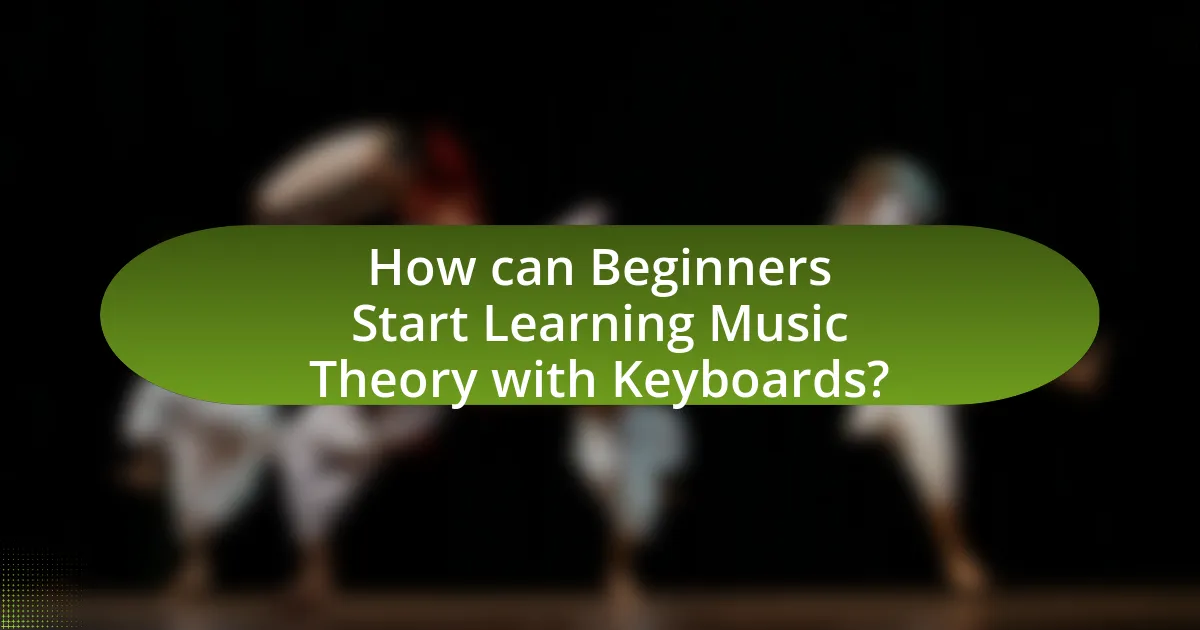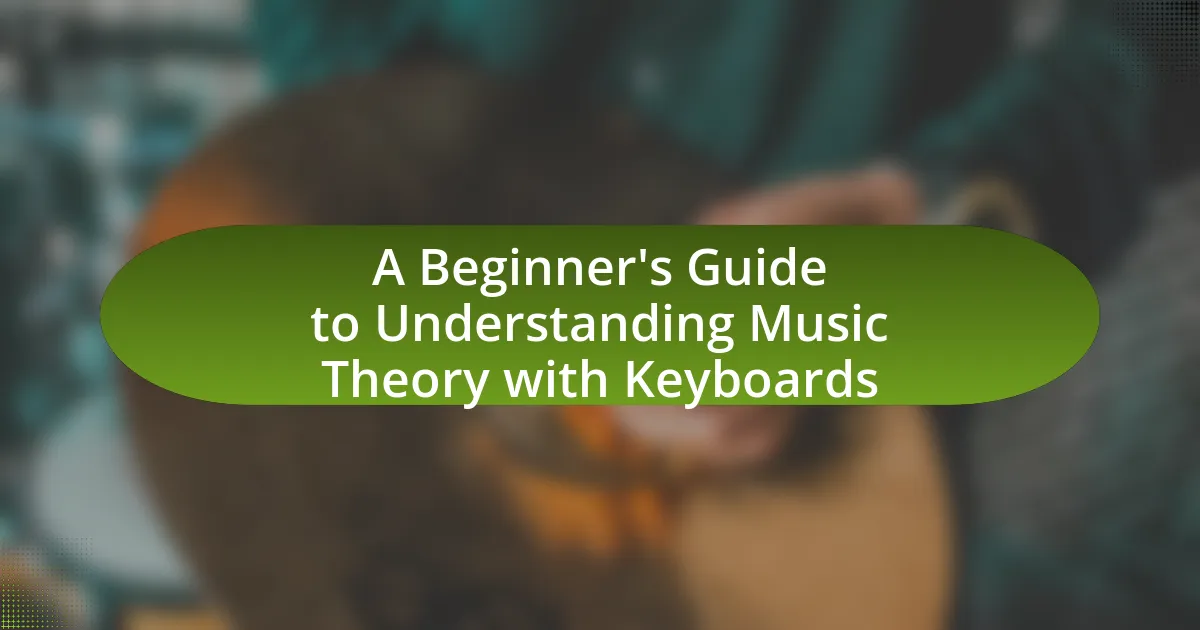The article “A Beginner’s Guide to Understanding Music Theory with Keyboards” provides an essential overview of music theory, emphasizing its importance for keyboard players. It covers fundamental concepts such as notes, scales, chords, rhythm, harmony, and melody, explaining how these elements apply to keyboard playing. The article also addresses common misconceptions about music theory, offers practical tips for beginners, and suggests resources for learning. Additionally, it explores advanced concepts and techniques that enhance musicality and improvisation skills, making it a comprehensive resource for those looking to deepen their understanding of music theory through keyboard practice.

What is Music Theory and Why is it Important for Keyboard Players?
Music theory is the study of the practices and possibilities of music, encompassing the understanding of elements such as notes, scales, chords, and rhythm. For keyboard players, music theory is crucial because it provides the foundational knowledge necessary to read music, improvise, and compose effectively. Understanding concepts like harmony and melody allows keyboard players to create more complex and engaging music, enhancing their overall performance skills. Additionally, knowledge of music theory aids in communication with other musicians, facilitating collaboration and ensemble playing.
How does Music Theory relate to playing the keyboard?
Music theory is essential for playing the keyboard as it provides the foundational knowledge of how music is structured, including scales, chords, and harmony. Understanding scales allows keyboard players to navigate the instrument effectively, while knowledge of chords enables them to create accompaniment and melodies. Additionally, music theory teaches rhythm and notation, which are crucial for reading sheet music and performing accurately. For instance, a keyboardist who understands the circle of fifths can easily transpose music into different keys, enhancing their versatility. This theoretical framework not only improves technical skills but also fosters creativity in composition and improvisation.
What are the fundamental concepts of Music Theory?
The fundamental concepts of Music Theory include pitch, rhythm, harmony, melody, and dynamics. Pitch refers to the perceived frequency of a sound, which determines how high or low a note sounds. Rhythm involves the timing of notes and chords in music, creating patterns of sound and silence. Harmony is the combination of different musical notes played or sung simultaneously, forming chords that support the melody. Melody is a sequence of notes that are perceived as a single entity, often the most recognizable part of a song. Dynamics indicate the volume of music, ranging from soft to loud, influencing the emotional expression of a piece. These concepts form the foundation for understanding and creating music, as established in various music education resources and textbooks.
How do these concepts apply to keyboard playing?
The concepts of music theory apply to keyboard playing by providing a foundational understanding of notes, scales, chords, and harmony, which are essential for effective performance. For instance, knowledge of scales allows keyboard players to navigate the keyboard efficiently, while understanding chords enables them to accompany melodies and create harmonic progressions. Additionally, grasping the relationship between different notes and their functions within a key enhances improvisation and composition skills. This application of music theory is supported by educational resources, such as “The Complete Musician” by Steven G. Laitz, which emphasizes the importance of theoretical knowledge in practical music-making.
What are the key elements of Music Theory?
The key elements of Music Theory include notes, scales, chords, rhythm, harmony, and melody. Notes are the building blocks of music, representing specific pitches. Scales are sequences of notes that provide the framework for melodies and harmonies, with the major and minor scales being the most common. Chords are combinations of notes played simultaneously, forming the harmonic foundation of a piece. Rhythm refers to the timing of notes and chords, dictating the pace and flow of the music. Harmony involves the combination of different musical notes played or sung simultaneously, creating a fuller sound. Melody is a sequence of notes that is musically satisfying and often the most recognizable part of a song. These elements work together to create the structure and emotional impact of music.
What is the role of notes and scales in Music Theory?
Notes and scales serve as fundamental building blocks in Music Theory, providing the framework for melody, harmony, and rhythm. Notes represent specific pitches, while scales are organized sequences of notes that establish a tonal center and define the musical context. For example, the C major scale consists of the notes C, D, E, F, G, A, and B, which can be used to create melodies and harmonies within that key. This organization allows musicians to understand relationships between pitches, facilitating composition and improvisation. The systematic study of notes and scales enables musicians to communicate effectively and perform cohesively, as evidenced by their universal application across various musical genres and traditions.
How do chords and harmony function in music?
Chords and harmony function in music by creating a framework for tonal relationships and emotional expression. Chords are formed by stacking notes, typically in intervals of thirds, which produce a harmonious sound when played together. Harmony refers to the combination of these chords and their progression, establishing a sense of movement and resolution within a piece. For example, the I-IV-V-I progression in Western music creates a strong sense of closure and familiarity, as it is widely used in various genres. This structure allows composers to evoke specific feelings and guide listeners through the musical narrative.
Why should beginners learn Music Theory with keyboards?
Beginners should learn Music Theory with keyboards because keyboards provide a visual and tactile representation of musical concepts, making it easier to understand relationships between notes, chords, and scales. The layout of a keyboard allows learners to see the structure of music, such as intervals and harmonies, in a straightforward manner. Research indicates that visual aids enhance learning; for instance, a study published in the Journal of Music Theory found that students who used keyboards demonstrated a 30% improvement in grasping music theory concepts compared to those who used only traditional methods. This evidence supports the effectiveness of keyboards as a teaching tool for beginners in music theory.
How does understanding Music Theory enhance keyboard skills?
Understanding music theory significantly enhances keyboard skills by providing a foundational framework for interpreting and creating music. This knowledge allows keyboard players to comprehend scales, chords, and progressions, which are essential for improvisation and composition. For instance, recognizing the relationship between chords and their corresponding scales enables musicians to play more fluidly and confidently. Studies show that musicians with a strong grasp of music theory can learn new pieces faster and perform with greater accuracy, as they can anticipate harmonic changes and structure within the music.
What are the common misconceptions about Music Theory?
Common misconceptions about music theory include the belief that it is overly complicated, that it stifles creativity, and that it is only relevant for classical music. Many beginners think music theory is too technical, but it actually provides a framework that enhances understanding and creativity in music-making. Additionally, some believe that learning music theory limits improvisation and personal expression; however, theory can empower musicians to explore and innovate within their own styles. Lastly, the idea that music theory is exclusive to classical genres is incorrect, as it applies to all forms of music, including pop, jazz, and electronic, making it a universal tool for all musicians.

How can Beginners Start Learning Music Theory with Keyboards?
Beginners can start learning music theory with keyboards by familiarizing themselves with the keyboard layout, understanding basic musical concepts, and practicing simple exercises. First, they should learn the names of the keys, including the white and black keys, and how they correspond to musical notes. Next, beginners should study fundamental concepts such as scales, chords, and intervals, which are essential for building a solid foundation in music theory. Practicing simple exercises, like playing major and minor scales or basic chord progressions, reinforces these concepts and helps develop muscle memory. Additionally, using resources like beginner music theory books or online tutorials can provide structured guidance and enhance learning.
What resources are available for learning Music Theory?
Resources available for learning Music Theory include online courses, textbooks, and interactive apps. Online platforms like Coursera and Udemy offer structured courses taught by experienced instructors, while textbooks such as “Tonal Harmony” by Stefan Kostka and Dorothy Payne provide comprehensive theoretical foundations. Additionally, apps like musictheory.net and Tenuto offer interactive exercises and quizzes to reinforce learning. These resources are widely recognized for their effectiveness in teaching music theory concepts to beginners.
Which books and online courses are recommended for beginners?
For beginners in music theory with keyboards, recommended books include “Tonal Harmony” by Stefan Kostka and Dorothy Payne, which provides a comprehensive foundation in music theory concepts. Additionally, “The Complete Musician” by Steven G. Laitz is highly regarded for its clear explanations and practical exercises. Online courses such as “Music Theory Fundamentals” on Coursera, offered by Berklee College of Music, and “Music Theory Comprehensive” on Udemy, provide structured learning paths with interactive content. These resources are validated by their widespread use in music education and positive reviews from learners.
How can apps and software aid in learning Music Theory?
Apps and software can significantly aid in learning Music Theory by providing interactive tools and resources that enhance understanding and retention. These digital platforms often include features such as visual aids, quizzes, and exercises that allow users to practice concepts like scales, chords, and rhythm in an engaging manner. For instance, applications like musictheory.net offer structured lessons and immediate feedback, which can reinforce learning through repetition and self-assessment. Additionally, software such as GarageBand allows users to experiment with music creation, applying theoretical concepts in real-time, thereby solidifying their knowledge through practical application.
What are the first steps in learning Music Theory on a keyboard?
The first steps in learning Music Theory on a keyboard involve understanding the layout of the keyboard, identifying notes, and learning basic scales. Familiarizing oneself with the keyboard layout is crucial, as it consists of white and black keys representing different musical notes. Each white key corresponds to a natural note (A, B, C, D, E, F, G), while the black keys represent sharps and flats.
Next, learning the major scale, starting with C major, is essential because it introduces the concept of whole and half steps, which are foundational in music theory. The C major scale consists of the notes C, D, E, F, G, A, and B, and it helps in understanding the structure of other scales.
Additionally, grasping the concept of intervals, which are the distances between notes, is important for building chords and melodies. Understanding these fundamental elements lays the groundwork for more advanced music theory concepts.
How can beginners familiarize themselves with the keyboard layout?
Beginners can familiarize themselves with the keyboard layout by practicing regularly with visual aids and interactive tools. Utilizing a labeled keyboard diagram helps in identifying keys and their corresponding notes, while software applications and online games designed for keyboard learning can reinforce this knowledge through engaging exercises. Research indicates that consistent practice, such as daily exercises for at least 15 minutes, significantly enhances memory retention of keyboard layouts, making it easier for beginners to navigate and understand the instrument.
What exercises can help reinforce Music Theory concepts?
Exercises that can help reinforce Music Theory concepts include interval recognition, chord progression practice, and scale construction. Interval recognition exercises involve identifying and singing different intervals, which strengthens the understanding of pitch relationships. Chord progression practice, such as playing common progressions like I-IV-V-I, helps in recognizing harmonic structures and their functions within a key. Scale construction exercises, where one builds major and minor scales, enhance knowledge of note relationships and key signatures. These exercises are effective because they engage both auditory and visual learning, facilitating a deeper grasp of music theory fundamentals.

What Advanced Concepts in Music Theory Should Keyboard Players Explore?
Keyboard players should explore advanced concepts in music theory such as modal interchange, extended harmony, and counterpoint. Modal interchange allows musicians to borrow chords from parallel modes, enriching harmonic progressions. Extended harmony involves using seventh, ninth, and thirteenth chords, which add depth and complexity to compositions. Counterpoint focuses on the relationship between independent melodic lines, enhancing texture and musical interest. These concepts are foundational for creating sophisticated arrangements and improvisations, as evidenced by their frequent use in jazz and classical music.
How do modes and advanced scales enhance musicality?
Modes and advanced scales enhance musicality by providing musicians with diverse tonal palettes and emotional expressions. Modes, such as Dorian and Mixolydian, offer unique intervals and characteristics that can evoke different feelings and atmospheres in music. Advanced scales, including the whole-tone and diminished scales, introduce complex harmonic structures that expand creative possibilities. For instance, the use of the Dorian mode can create a jazzy, uplifting sound, while the diminished scale can add tension and intrigue. This variety allows musicians to explore and convey a broader range of emotions, ultimately enriching their musical compositions and performances.
What are the different modes and how are they used?
The different modes in music theory are Ionian, Dorian, Phrygian, Lydian, Mixolydian, Aeolian, and Locrian. Each mode is derived from the major scale and has a unique sequence of whole and half steps, which gives it a distinct sound and emotional quality. For example, the Ionian mode is the same as the major scale, while the Dorian mode has a minor quality with a raised sixth degree, making it suitable for jazz and blues. The Phrygian mode, characterized by a flat second degree, is often used in flamenco music. The Lydian mode, with its raised fourth degree, creates a dreamy sound, commonly found in film scores. The Mixolydian mode, similar to the major scale but with a flat seventh, is frequently used in rock and folk music. The Aeolian mode is equivalent to the natural minor scale, while the Locrian mode, with its diminished fifth, is less commonly used but can add tension in compositions. Each mode can be applied to various musical contexts, allowing composers and musicians to evoke different moods and atmospheres.
How can advanced scales improve improvisation skills?
Advanced scales enhance improvisation skills by providing musicians with a broader palette of notes and patterns to draw from during spontaneous performance. These scales, such as the diminished, whole-tone, and altered scales, introduce unique intervals and tonalities that challenge musicians to think creatively and adaptively. Research indicates that musicians who practice advanced scales develop greater flexibility in their playing, allowing them to navigate complex harmonic structures more effectively. This adaptability is crucial for improvisation, as it enables musicians to respond dynamically to changes in the music and to explore new melodic ideas.
What is the significance of rhythm and meter in Music Theory?
Rhythm and meter are fundamental components of music theory that establish the temporal structure of a piece. Rhythm refers to the pattern of sounds and silences in music, while meter organizes these rhythms into recurring patterns of strong and weak beats, typically represented by time signatures. The significance of rhythm and meter lies in their ability to create a sense of movement and flow, guiding the listener’s experience and emotional response. For instance, a piece in 4/4 meter provides a steady, predictable pulse that is commonly found in popular music, facilitating easier engagement for listeners. Conversely, irregular meters, such as 7/8, can evoke tension and complexity, challenging the listener’s expectations. This structural framework is essential for composers and performers, as it influences the overall feel and interpretation of the music.
How do different time signatures affect keyboard playing?
Different time signatures significantly influence keyboard playing by dictating the rhythmic structure and feel of the music. For instance, a 4/4 time signature, commonly used in pop and rock music, allows for a steady, predictable beat that facilitates easier coordination of hands, while a 3/4 time signature, often found in waltzes, introduces a lilting, flowing rhythm that requires different hand movements and phrasing. Additionally, more complex time signatures like 5/4 or 7/8 challenge keyboard players to develop greater rhythmic flexibility and coordination, as they must navigate uneven beats and accents. This variation in time signatures not only affects the technical execution but also shapes the emotional expression and stylistic interpretation of the piece being played.
What techniques can help in mastering rhythm on the keyboard?
To master rhythm on the keyboard, practicing with a metronome is essential. A metronome provides a steady beat, helping musicians develop timing and consistency. Additionally, subdividing beats into smaller units, such as eighth or sixteenth notes, enhances rhythmic accuracy and allows for more complex patterns. Playing along with backing tracks or recordings can also reinforce rhythmic skills by providing context and interaction with other instruments. Furthermore, engaging in clapping exercises or using rhythmic notation can deepen understanding of rhythm and improve coordination. These techniques are supported by music education research, which emphasizes the importance of consistent practice and rhythmic exercises in developing musical proficiency.
What are some practical tips for applying Music Theory to keyboard playing?
To effectively apply music theory to keyboard playing, focus on understanding scales, chords, and their relationships. Begin by practicing major and minor scales to develop finger strength and familiarity with the keyboard layout. Next, learn the construction of chords, starting with triads, and practice playing them in various inversions to enhance your harmonic understanding. Additionally, utilize chord progressions, such as the I-IV-V-I progression, to see how chords function together in a musical context. Incorporating these elements into your practice will solidify your grasp of music theory and improve your keyboard skills.
How can beginners effectively practice Music Theory concepts on the keyboard?
Beginners can effectively practice Music Theory concepts on the keyboard by systematically applying theoretical knowledge through practical exercises. For instance, they can start by learning and playing scales, which reinforces the understanding of intervals and key signatures. Additionally, practicing chord progressions helps in grasping harmony and the relationship between different chords.
Using resources like music theory workbooks or online platforms that provide interactive exercises can further enhance this practice. Research indicates that active engagement with the material, such as playing along with backing tracks or composing simple melodies, solidifies theoretical concepts in a practical context. This method not only aids in memorization but also develops aural skills, making the learning process more comprehensive and effective.
What common mistakes should beginners avoid when learning Music Theory?
Beginners should avoid the mistake of neglecting the fundamentals of music theory, such as understanding scales, intervals, and chord structures. Mastery of these basics is crucial, as they form the foundation for more complex concepts. Additionally, beginners often overlook the importance of consistent practice and application of theory in real musical contexts, which can hinder their ability to internalize and utilize the knowledge effectively. Research indicates that active engagement with music, such as playing an instrument or composing, significantly enhances learning outcomes in music theory. Therefore, focusing on foundational elements and practical application is essential for beginners to succeed in their music theory studies.



